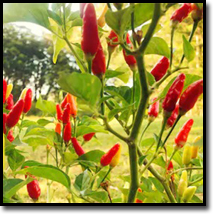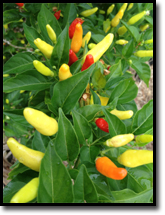
Growing Hawaiian Chili Peppers
Introduction
| Chili Peppers (Capsicum annuum) are part of the Solanaceae family. This botanical family, commonly known as the nightshades, includes other species like tomatoes, potatoes, eggplant and tobacco. |  |
Chili peppers originated in Mexico. After the Colombian Exchange, many cultivars of chili pepper spread across the world, used for both food and traditional medicine.
Despite their popularity, these Hawaiian chili peppers are not readily available in supermarkets. You could find them at farmers markets, or just grow you own!
Types
There are two main types of Hawaiian chili peppers; the "Hawaiian Chili Pepper" and the "Waialua Chili Pepper".
Hawaiian Chili Pepper
Waialua Chili Pepper
The Scoville scale measures the “heat” displaced by peppers and other foods. All chili pepper varietals register differently on this scale. For example, the mild and benign sweet bell pepper registers at zero (as in; no spicy effect). The jalapeno and chipotle peppers, by comparison, register between 2,500 and 8,000 on the scale.
Hawaiian Chili Peppers are smaller spicy, typical red chili peppers. It ranges in between 50,000 and 70,000 on the Scoville scale.
Waialua chili pepper is Jalapeno shaped, weighing about an ounce. Pepper is resistant to Bacterial Wilt and is tolerant to root knot nematodes. Fruits mature to a beautiful red color and is sweeter flavored than Jalepeno. Fruits are about 1.5 to 2 inches in length.
Hawaiian Chili Pepper
Waialua Chili Pepper
Germination & Propagation
Hawaiian peppers are easy to start from seed, however, starters are readily available for a few dollars at most stores if you want to get a head start.
The seeds germinate within ten to fourteen days. Seeds are best stored in the refrigerator and can be purchased directly from us via our Seed Store. We get our seed stock directly from the College of Tropical Agriculture and Human Resources (C/T/A/H/R), University of Hawaii at Mānoa.
Plant one or two seeds per starter pot in a quarter inch hole and cover lightly with soil. Keep watered and moist until the seeds form seedlings. Thin the pots to just one sprout per container.
Propagate from cuttings: While growing peppers from cuttings is more common with ornamental type peppers, any type of pepper plant can be used. Rooting a pepper cutting is a great way to save and regrow a favorite pepper variety or grow a hybrid variety without saving seeds.
With a sharp knife or scissors cut about 3 to 4 inches of the sucker or new growth at the tip of the branch. Then, you can simply immerse the tomato cutting in water or plant it directly into mild some soil medium. In water, the cutting should root in about 3-4 weeks and will be ready to transplant. Be sure to replace the water daily.
A sharp pair of scissors is a crucial tool for taking clones.
Rooting cuttings is not complicated, a little imagination goes a long way.
Planting
To plant the starters, simply dig an approximately 3″ by 3″ hole in a location that receives good sun exposure. Gently place the starter pepper in the hole and cover with dirt. Plant additional starters between 12 and 18 inches apart. Hawaiian chili peppers require consistent water so don't let the soil get too dry.
Peppers can be grown in the ground or a container. They can also be easily grown on a lanai or compact area that gets decent sun.
To transplant, carefully remove the starter chili pepper plant from the original container and place it into the hole in the new, larger container.
If you are using a pot to grow peppers, it should be large enough to allow the pepper plants to grow properly. I use 5-gallon gallon containers with plenty of drainage. Use the Best Hawaiian Soil Mix once seedlings have established themselves.
Hawaiian chili peppers are easy to grow and, unlike some other pepper plants, produce a great yield. They are perfectly suited to grow in Hawaii since these peppers grow best in warm soil. They will grow nicely year-round.
Trim plants back when they gets to be about a foot tall. They will become fuller, ultimately producing more fruit. After a couple of months, you will notice small, white, delicate flowers. These will turn into yellowish-green peppers.
White flowers eventually turn into yellow fruit which mature into red peppers.
Self pollenating, most pepper plants do not require any assistance.
Sun and Water
Chili pepper plants require about four to eight hours of direct sunlight a day. Yields and pepper sizes will be larger in sunnier locations.
Chili pepper plants need a lot of water at all times. It is a good idea to keep the soil moist and watering in the morning is best. During the rainy season, keep watering to a minimum but during the hot summer months, it is best to water consistently especially if you are using containers.
Fertilizing
Chili peppers are mild to medium feeders. Their nutritional needs change over time. Early in their growing phase they are producing stems and leaves and as such need somewhat more nitrogen.
When the plants start growing fruit, the phosphorous requirements will increase. I lightly top feed with a balanced guano blend and add a little blood-meal until they start producing peppers. Cut plant food schedule in half when the flowers start developing fruit.
When the plants start growing fruit, the phosphorous requirements will increase. I lightly top feed with a balanced guano blend and add a little blood-meal until they start producing peppers. Cut plant food schedule in half when the flowers start developing fruit.
Harvesting
The Waialua chili peppers mature in about 75-80 days and the Hawaiian chill pepper takes a little over 3 months. Once the fruit is bright red it can be snipped from the plant.
Peppers can be dried by just leaving them out and flipping them around every day, or they will last a couple of weeks in the fridge.















